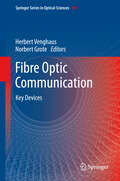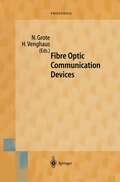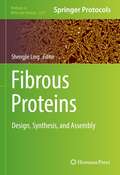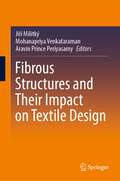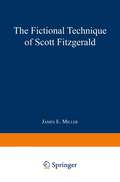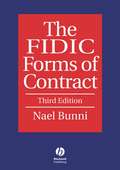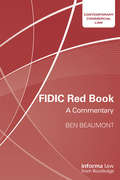- Table View
- List View
Fibre Optic Communication: Key Devices (Springer Series in Optical Sciences #161)
by Norbert Grote Herbert VenghausThe book gives an in-depth description of key devices of current and next generation fibre optic communication networks. Devices treated include semiconductor lasers, optical amplifiers, modulators, wavelength filters and other passives, detectors, all-optical switches, but relevant properties of optical fibres and network aspects are included as well. The presentations include the physical principles underlying the various devices, technologies used for their realization, typical performance characteristics and limitations, but development trends towards more advanced components are also illustrated. This new edition of a successful book was expanded and updated extensively. The new edition covers among others lasers for optical communication, optical switches, hybrid integration, monolithic integration and silicon photonics. The main focus is on Indium phosphide-based structures but silicon photonics is included as well. The book covers relevant principles, state-of-the-art implementations, status of current research as well as expected future components.
Fibre Optic Communication: Key Devices (Springer Series in Optical Sciences #161)
by Herbert Venghaus and Norbert GroteThe book gives an in-depth description of the key devices of current and next generation fibre optic communication networks. In particular, the book covers devices such as semiconductor lasers, optical amplifiers, modulators, wavelength filters, and detectors but the relevant properties of optical fibres as well. The presentations include the physical principles underlying the various devices, the technologies used for the realization of the different devices, typical performance characteristics and limitations, and development trends towards more advanced components are also illustrated. Thus the scope of the book spans relevant principles, state-of-the-art implementations, the status of current research and expected future components.
Fibre Optic Communication Devices (Springer Series in Photonics #4)
by Norbert Grote Herbert VenghausOptoelectronic devices and fibre optics are the basis of cutting-edge communication systems. This monograph deals with the various components of these systems, including lasers, amplifiers, modulators, converters, filters, sensors, and more.
Fibre Optic Methods for Structural Health Monitoring
by Branko Glisic Daniele InaudiThe use of fibre optic sensors in structural health monitoring has rapidly accelerated in recent years. By embedding fibre optic sensors in structures (e.g. buildings, bridges and pipelines) it is possible to obtain real time data on structural changes such as stress or strain. Engineers use monitoring data to detect deviations from a structure’s original design performance in order to optimise the operation, repair and maintenance of a structure over time. Fibre Optic Methods for Structural Health Monitoring is organised as a step-by-step guide to implementing a monitoring system and includes examples of common structures and their most-frequently monitored parameters. This book: presents a universal method for static structural health monitoring, using a technique with proven effectiveness in hundreds of applications worldwide; discusses a variety of different structures including buildings, bridges, dams, tunnels and pipelines; features case studies which describe common problems and offer solutions to those problems; provides advice on establishing mechanical parameters to monitor (including deformations, rotations and displacements) and on placing sensors to achieve monitoring objectives; identifies methods for interpreting data according to construction material and shows how to apply numerical concepts and formulae to data in order to inform decision making. Fibre Optic Methods for Structural Health Monitoring is an invaluable reference for practising engineers in the fields of civil, structural and geotechnical engineering. It will also be of interest to academics and undergraduate/graduate students studying civil and structural engineering.
Fibre Reinforced Concrete: RILEM-fib International Symposium on FRC (BEFIB) in 2020 (RILEM Bookseries #30)
by Pedro Serna Aitor Llano-Torre José R. Martí-Vargas Juan Navarro-GregoriThis volume highlights the latest advances, innovations, and applications in the field of fibre reinforced concrete (FRC) and discusses a diverse range of topics concerning FRC: rheology and early-age properties, mechanical properties, codes and standards, long-term properties, durability, analytical and numerical models, quality control, structural and Industrial applications, smart FRC’s, nanotechnologies related to FRC, textile reinforced concrete, structural design and UHPFRC. The contributions present improved traditional and new ideas that will open novel research directions and foster multidisciplinary collaboration between different specialists. Although the symposium was postponed, the book gathers peer-reviewed papers selected in 2020 for the RILEM-fib International Symposium on Fibre Reinforced Concrete (BEFIB).
Fibre Reinforced Concrete: X RILEM-fib International Symposium on Fibre Reinforced Concrete (BEFIB) 2021 (RILEM Bookseries #36)
by Pedro Serna Aitor Llano-Torre José R. Martí-Vargas Juan Navarro-GregoriThis volume highlights the latest advances, innovations, and applications in the field of fibre-reinforced concrete (FRC), as presented by scientists and engineers at the RILEM-fib X International Symposium on Fibre Reinforced Concrete (BEFIB), held in Valencia, Spain, on September 20-22, 2021. It discusses a diverse range of topics concerning FRC: technological aspects, nanotechnologies related with FRC, mechanical properties, long-term properties, analytical and numerical models, structural design, codes and standards, quality control, case studies, Textile-Reinforced Concrete, Geopolymers and UHPFRC. After the symposium postponement in 2020, this new volume concludes the publication of the research works and knowledge of FRC in the frame of BEFIB from 2020 to 2021 with the successful celebration of the hybrid symposium BEFIB 2021. The contributions present traditional and new ideas that will open novel research directions and foster multidisciplinary collaboration between different specialists.
Fibre-reinforced Concretes for High-performance Structures: Building a more sustainable future
by Andreas LampropoulosFibre-reinforced Concretes for High-performance Structures focuses on fibre-reinforced concrete, ultra-high-performance fibre-reinforced concrete and geopolymer concrete and their use in the construction of structures. It deals with recent developments in the area of concrete types for enhanced structural performance and sustainability. Designed as a guide to filling the knowledge gap between research and use in industry, this book presents key information about the development, performance and design of three main materials and critically analyses them to highlight the key mechanical properties and durability characteristics. Design aspects are covered using both research outcomes and available guidelines/code provisions. Critical evaluation of the mechanical properties of all the examined materials are presented in addition to environmental end economic considerations. Selected case studies are also presented for the examined concrete types in a consistent form, focusing on the material properties and on the construction process. Finally, recent findings on the application of the examined materials for the structural strengthening of existing structures are presented and the efficiency of the use of the examined materials is highlighted. This book considers each material in turn focusing on material selection and design of concrete mixes mechanical performance and durability design of structural elements using these materials selected case studies. This title is an essential read for engineers and concrete specialists, from students and technicians to practising engineers and researchers, and those looking for sustainable solutions to civil engineering projects involving the selection of specific concretes.
Fibre Science and Technology (Soviet Advanced Composites Technology Series #5)
by V. I. KostikovFibre Science and Technology is one of six titles in a coherent and definitive series of volumes dedicated to advanced composite materials research, development and usage in the former Soviet Union. Much of the information presented has been classified until recently. Thus each volume provides a unique insight into hitherto unknown research and development data. This volume deals with the basic components of a composite material, namely the reinforcement and the encasing matrix material. Beginning with a specification of a range of reinforcing fibres (glass, carbon, organic, inorganic, ceramic), the book then considers in detail the development of such fibres and the significant range of properties achieved. An extensive test methodology used to evaluate the physical and mechanical properties of each type of fibre matrix combination is presented, and the production method employed for each constituent part is described. This book will be of interest to anyone involved in research or development in composite materials science and technology, both in industry and universities.
Fibre Structure (Woodhead Publishing India in Textiles)
by Siba Prasad MishraFibre Structure states that each and every fibre from their manufacturing (man-made fibres) or during development (natural fibres) creates and develops its own and specialized structure. It might be the chemical structure, crystalline structure, amorphous structure and/or morphology. This structure can be modified during processing. The structure equally influences the processing conditions as well as the properties of the fibre. With this background, the present book deals with different fibres and their structures. Different aspects of structure are dealt separately in a concise and compact manner. This will serve as a reference for researchers, technologists as well as professionals as a reference book to know about the structure of different fibres and their measurement.
Fibres to Smart Textiles: Advances in Manufacturing, Technologies, and Applications (Textile Institute Professional Publications)
by Asis Patnaik Sweta PatnaikFibres to Smart Textiles: Advances in Manufacturing, Technologies, and Applications offers comprehensive coverage of the fundamentals and advances in the textile and clothing manufacturing sectors. It describes the basics of fibres, yarns, and fabrics and their end use in the latest developments and applications in the field and addresses environmental impacts from textile processes and how to minimize them. This book serves as a single comprehensive source discussing textile fibres, yarn formation, filament formation techniques, woven fabric formation, knitting technologies, nonwoven manufacturing technologies, braiding technologies, and dyeing, printing, and finishing processes. Testing of textile materials, environmental impacts of textile processes and use of CAD and CAM in designing textile products are also included. The book also discusses applications including textile composites and biocomposites, technical textiles, smart textiles, and nanotextiles. With chapters authored by textile experts, this practical book offers guidance to professionals in textile and clothing manufacturing and shows how to avoid potential pitfalls in product development.
Fibres to Smart Textiles: Advances in Manufacturing, Technologies, and Applications (Textile Institute Professional Publications)
by Asis Patnaik Sweta PatnaikFibres to Smart Textiles: Advances in Manufacturing, Technologies, and Applications offers comprehensive coverage of the fundamentals and advances in the textile and clothing manufacturing sectors. It describes the basics of fibres, yarns, and fabrics and their end use in the latest developments and applications in the field and addresses environmental impacts from textile processes and how to minimize them. This book serves as a single comprehensive source discussing textile fibres, yarn formation, filament formation techniques, woven fabric formation, knitting technologies, nonwoven manufacturing technologies, braiding technologies, and dyeing, printing, and finishing processes. Testing of textile materials, environmental impacts of textile processes and use of CAD and CAM in designing textile products are also included. The book also discusses applications including textile composites and biocomposites, technical textiles, smart textiles, and nanotextiles. With chapters authored by textile experts, this practical book offers guidance to professionals in textile and clothing manufacturing and shows how to avoid potential pitfalls in product development.
Fibrous and Textile Materials for Composite Applications (Textile Science and Clothing Technology)
by Sohel Rana Raul FangueiroThis book focuses on the fibers and textiles used in composite materials. It presents both existing technologies currently used in commercial applications and the latest advanced research and developments. It also discusses the different fiber forms and architectures, such as short fibers, unidirectional tows, directionally oriented structures or advanced 2D- and 3D-textile structures that are used in composite materials. In addition, it examines various synthetic, natural and metallic fibers that are used to reinforce polymeric, cementitious and metallic matrices, as well as fiber properties, special functionalities, manufacturing processes, and composite processing and properties. Two entire chapters are dedicated to advanced nanofiber and nanotube reinforced composite materials. The book goes on to highlight different surface treatments and finishes that are applied to improve fiber/matrix interfaces and other essential composite properties. Although a great deal of information about fibers and textile structures used for composite applications is already available, this is the only book currently available that discusses all types of fibers and structures used to reinforce polymers, cement, metal or soil to improve their general performance and multi-functional behaviors. As such, it fills an important gap in the available literature and provides a valuable resource for a wide range of students and researchers from academia and industry.
Fibrous Composites in Structural Design
by Edward M. LenoeThe Fourth Conference on Fibrous Composites in Structural Design was a successor to the First-to-Third Conferences on Fibrous Composites in Flight Vehicle Design sponsored by the Air Force (First and Second Conferences, September 1973 and May 1974) and by NASA (Third Conference, November 1975) which were aimed at focusing national attention on flight vehicle applications of a new class of fiber reinforced materials, the advanced com posites, which afforded weight savings and other advantages which had not been previously available. The Fourth Conference, held at San Diego, California, 14-17 November 1978, was the fi rst of these conferences to be jointly sponsored by the Army, Navy and Ai r Force together with NASA, as well as being the first to give attention to non-aerospace applications of fiber reinforced composites. While the design technology for aerospace applications has reached a state of relative maturity, other areas of application such as mi litary bridging, flywheel energy storage systems, ship and surface vessel components and ground vehicle components are in an early stage of development, and it was an important objective to pinpoint where careful attention to structural design was needed in such applications to achfeve maximum structural performance payoff together with a high level of reliability and attractive economics.
Fibrous Polymeric Composites: Environmental Degradation and Damage
by Bankim Chandra Ray Rajesh Kumar Prusty Dinesh Kumar RathoreThis book emphasizes the scientific origin of deformation and damage of FRP composites under various environmental effects and analyses present understanding on degradation mechanisms, role of interfaces and addition of nanofillers Discusses micro-characterization of composites and interfaces, also includes micro-mechanisms and microscopic evidences to establish the structure-property correlation Elucidates advantages and limitations of FRP composites in supercritical applications
Fibrous Polymeric Composites: Environmental Degradation and Damage
by Bankim Chandra Ray Rajesh Kumar Prusty Dinesh Kumar RathoreThis book emphasizes the scientific origin of deformation and damage of FRP composites under various environmental effects and analyses present understanding on degradation mechanisms, role of interfaces and addition of nanofillers Discusses micro-characterization of composites and interfaces, also includes micro-mechanisms and microscopic evidences to establish the structure-property correlation Elucidates advantages and limitations of FRP composites in supercritical applications
Fibrous Proteins: Design, Synthesis, and Assembly (Methods in Molecular Biology #2347)
by Shengjie LingThis detailed volume explores fibrous proteins widely present in different biological tissues or biological structural materials. The book begins by introducing the structure of representative fibrous proteins, including animal silks, collagen, elastin, resilin, and keratin, and it then continues by providing detailed experimental protocols for the synthesis, assembly, and characterization of natural, regenerated, and recombinant fibrous proteins. Written for the highly successful Methods in Molecular Biology series, chapters include introductions to their respective topics, lists of the necessary materials and reagents, step-by-step, readily reproducible laboratory protocols, and tips on troubleshooting and avoiding known pitfalls. Authoritative and practical, Fibrous Proteins: Design, Synthesis, and Assembly is an ideal guide for researchers aiming to master fibrous protein preparations with the aid of this broad and interdisciplinary perspective on understanding the structure-property-function relationships of natural and reconstituted fibrous proteins.
Fibrous Structures and Their Impact on Textile Design
by Jiří Militký Mohanapriya Venkataraman Aravin Prince PeriyasamyBooks on Textiles tend to focus solely on aesthetic or technical points of view. Designers’ understanding of special technical aspects of textile structure or the ability of researchers to grasp the design aspects would result in quantum leaps in innovations and creativity in the Textile domain. This book presents a holistic view integrating the viewpoints of designers and researchers. It presents previously unexplored features or possibilities, mainly in the field of textile structure constructions and characteristics. The main aim is a unique proper blending of both the technical and aesthetic sides of textile. Without compromising on the technicalities, it simplifies complex concepts to elevate the understanding of fashion designers. On the other hand, it also provides a viewpoint on aesthetics. The chapters are designed to provide a good balance of content for both fashion designers and professionals. The initial chapter sets the foundation of understanding with a healthy discussion about the latest technical trends of textiles’ functionalities and their new applications. A dedicated chapter discusses the practical use of lighting effects of side-emitting optical fibers in conjunction with color effects for textile design purposes. Further chapters deal with smart textiles design in the context of sensation and perception, basic aspects of textiles structures necessary for their rational design, and color characteristics of materials useful for designers. The book includes a special chapter on analyzing the business landscape of textile design. Overall, this book is expected to cater to the needs and give special knowledge important for both textile specialists and fashion designers.
FIDIC 2017: The Contract Manager’s Handbook
by Geoffrey SmithFIDIC 2017: The Contracts Manager’s Handbook is a practical guide to the effective use of the management procedures within the 2017 FIDIC suite of contracts. The book gives step-by-step guidance through the use of flowcharts, timelines and case studies drawn from the author’s experience, showing how to manage the contract effectively, and explaining exactly what is expected of each of the parties and when. Key features of the book suitable for all levels – for experienced users the book highlights and explains the developments introduced in the latest editions; and for new users the book presents a complete overview and step-by-step guide on using the contracts effectively clear explanations of contractual provisions behind the procedures and potentially important legal requirements coverage across the project life cycle, emphasising the importance of the provisions during the pre-contract phase, and procedures for efficient contract management post-contract award a guide to the second editions of FIDIC Red, Yellow and Silver Books, as well as special provisions imposed by the World Bank and other Multilateral Development Banks, and modifications introduced by the 2022 Reprints. FIDIC 2017: The Contracts Manager’s Handbook is an essential companion for all users of the FIDIC 2017 suite of contracts, and in particular for users from any level or position in the management chain, whether Employer, Engineer or Contractor.
The FIDIC Forms of Contract
by Nael G. BunniIn September 1999, FIDIC introduced its new Suite of Contracts, which included a “new” Red, Yellow, Silver and Green forms of contract. The “new” Red Book was intended to replace the 1992 fourth edition of the Red Book, with the ambition that its use would cease with time. This ambition has not materialised and is unlikely to do so in the future. Despite the importance of the 1999 Forms, there has been very little published on the new concepts adopted in them and how they interact with the previous forms. This important work considers these aspects together with the many developments affecting the fourth edition of the Red Book that have taken place since 1997, when the second edition of this book was published, and relates them to key contracting issues. It is written by a chartered engineer, conciliator and international arbitrator with wide experience in the use of the FIDIC Forms and in the various dispute resolution mechanisms specified in them. Important features of this book include: · background and concepts of the various forms of contract; · a detailed comparison of the wording of the1999 three main forms, which although similar in nature; it nevertheless significantly differs in certain areas where the three forms diverge due to their intended purpose; · analysis of the rights and obligations of the parties involved in the contract and the allocation of risks concerned; · a range of ‘decision tree’ charts, analysing the main features of the 1992 Red Book, including risks, indemnities and insurances, claims and counterclaims, variations, procedure for claims, programme and delay, suspension, payments and certificates, dispute resolution mechanisms, and dispute boards; · a much enlarged discussion of the meaning of “claim” and “dispute” and the types of claim with a discussion of the Notice provision in the 1999 forms of contract for the submittal of claims by a contractor and by an employer; · the FIDIC scheme of indemnities and insurance requirements; and the methods of dispute resolution provided by the various forms of contract; and · five new chapters in this third edition, the first four chapters deal with each of the 1999 forms and the fifth chapter is confined to the topic of Dispute Boards.
FIDIC Red Book: A Commentary (Contemporary Commercial Law)
by Ben BeaumontWritten by a member of the FIDIC President’s List of Adjudicators, this detailed and critical commentary on the FIDIC Red Book provides authoritative guidance and recommendations for best practice. Focusing on each Clause of the Condition of Contract, this book identifies pitfalls and logistics issues associated with its enforcement and ancillary processes, to give readers an advantage when operating with the FIDIC Red Book. Intended to promote the best use and growth of FIDIC, this guide will be essential for all users of the FIDIC Red Book, be they contractors, lawyers, engineers, students training to join these industries or any professional involved in the resolution of disputes involving the FIDIC Red Book.
FIDIC Red Book: A Commentary (Contemporary Commercial Law)
by Ben BeaumontWritten by a member of the FIDIC President’s List of Adjudicators, this detailed and critical commentary on the FIDIC Red Book provides authoritative guidance and recommendations for best practice. Focusing on each Clause of the Condition of Contract, this book identifies pitfalls and logistics issues associated with its enforcement and ancillary processes, to give readers an advantage when operating with the FIDIC Red Book. Intended to promote the best use and growth of FIDIC, this guide will be essential for all users of the FIDIC Red Book, be they contractors, lawyers, engineers, students training to join these industries or any professional involved in the resolution of disputes involving the FIDIC Red Book.
FIDIC Red Book, Revised edition: A companion to the 2017 Construction Contract
by Jakob B. SørensenFIDIC Red Book is a practical guide for anyone involved in preparing, administering, or contributing to the FIDIC suite of contracts, 2017 edition. This revised edition a number of recent developments including the 2022 amendments, further examples drawn from practice, impacts of COVID-19 and the war in Ukraine, as well as guidance on use of FIDIC Contracts for projects using Building Information Modelling. Designed as a companion for both the first-time and also more experienced user the book presents an accessible guide to the 21 clauses of the 2017 FIDIC Conditions of Contract, using the Conditions of Contract for Construction (Red Book) as a basis. Opening chapters provide an introduction to the entire FIDIC suite of contracts. Part 2 provides a clause-by-clause introduction to each of the Clauses and Sub-Clauses in the Red Book, and explain how they are interlinked. A final section includes a concise practical guide to the use of the FIDIC Conditions, and a summary of special provisions discussed in Part 2. Drawing on the author’s 35 years’ experience with the FIDIC Conditions of Contract, this accessible guide to the FIDIC Red Book provides an ideal introduction for first time users of the FIDIC conditions and will also serve as a very useful handbook and practical commentary for more experienced users.
FIDIC Red Book, Revised edition: A companion to the 2017 Construction Contract
by Jakob B. SørensenFIDIC Red Book is a practical guide for anyone involved in preparing, administering, or contributing to the FIDIC suite of contracts, 2017 edition. This revised edition a number of recent developments including the 2022 amendments, further examples drawn from practice, impacts of COVID-19 and the war in Ukraine, as well as guidance on use of FIDIC Contracts for projects using Building Information Modelling. Designed as a companion for both the first-time and also more experienced user the book presents an accessible guide to the 21 clauses of the 2017 FIDIC Conditions of Contract, using the Conditions of Contract for Construction (Red Book) as a basis. Opening chapters provide an introduction to the entire FIDIC suite of contracts. Part 2 provides a clause-by-clause introduction to each of the Clauses and Sub-Clauses in the Red Book, and explain how they are interlinked. A final section includes a concise practical guide to the use of the FIDIC Conditions, and a summary of special provisions discussed in Part 2. Drawing on the author’s 35 years’ experience with the FIDIC Conditions of Contract, this accessible guide to the FIDIC Red Book provides an ideal introduction for first time users of the FIDIC conditions and will also serve as a very useful handbook and practical commentary for more experienced users.
FIDIC Silver Book, Revised edition: A companion to the 2017 EPC/Turnkey Contract
by Jakob B. SørensenFIDIC Silver Book is a practical guide for anyone involved in preparing, administering, or contributing to the FIDIC suite of contracts, 2017 edition. This revised edition responds to a number of recent developments including the 2022 amendments, further examples drawn from experience with the 2017 contracts, impacts of COVID-19 and the war in Ukraine, as well as guidance on use of FIDIC Contracts for projects using Building Information Modelling. Designed as a companion for both the first-time and also more experienced user the book presents an accessible guide to the 21 clauses of the 2017 FIDIC Conditions of Contract, using the Conditions of Contract for EPC/Turnkey Projects (Silver Book) as a basis. Opening chapters provide an introduction to the entire FIDIC suite of contracts. Part 2 provides a clause-by-clause introduction to each of the Clauses and Sub-Clauses in the Silver Book, and explain how they are interlinked. A final section includes a concise practical guide to the use of the FIDIC Conditions, and a summary of special provisions discussed in Part 2. Drawing on the author’s 35 years’ experience with the FIDIC Conditions of Contract, this accessible guide to FIDIC Silver Book provides an ideal introduction for first time users of the FIDIC conditions of contract and will also serve as a very useful handbook and practical commentary for more experienced users.

